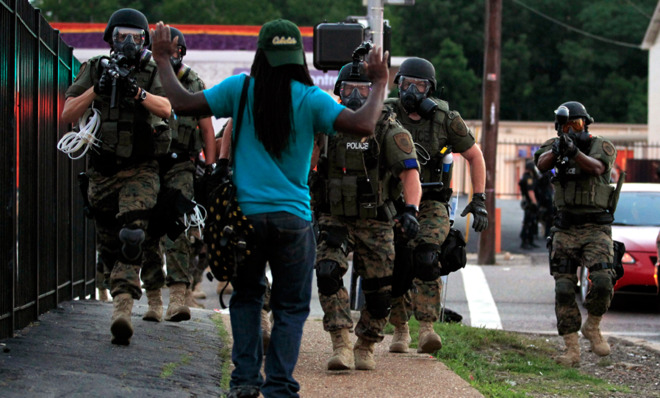The fiasco in Ferguson shows why you don't give military equipment to cops
The police in Ferguson are bristling with military gear. Too bad they have no clue how to use it.


Last weekend in Ferguson, Missouri, an 18-year-old named Michael Brown, who was two days from starting college, was shot to death by the police. The circumstances surrounding his death remain in dispute (though an eyewitness says he was virtually executed on the street), but that hasn't stopped locals in this St. Louis suburb from demonstrating for justice and condemning police brutality. The protests lapsed into serious unrest on Sunday, with opportunists taking advantage of the chaos to loot local businesses, and have continued every day since.
Throughout all this, police from Ferguson, St. Louis County, and other departments have responded by arming themselves to the teeth with heavy-duty military equipment. Concerns about "police militarization" in America — the origins of which have been discussed to great extent by Radley Balko — are rampant.
But the great irony of this story is that the military itself would never behave so crudely. And that is precisely why it is beyond reckless to let a bunch of local cops get their hands on a high-grade military arsenal.
The Week
Escape your echo chamber. Get the facts behind the news, plus analysis from multiple perspectives.

Sign up for The Week's Free Newsletters
From our morning news briefing to a weekly Good News Newsletter, get the best of The Week delivered directly to your inbox.
From our morning news briefing to a weekly Good News Newsletter, get the best of The Week delivered directly to your inbox.
First, let's see what they got. Here's a representative sample from Paul Szoldra, who served in Afghanistan himself:
In photos taken on Monday, we are shown a heavily armed SWAT team. They have short-barreled 5.56-mm rifles based on the military M4 carbine, with scopes that can accurately hit a target out to 500 meters. On their side they carry pistols. On their front, over their body armor, they carry at least four to six extra magazines, loaded with 30 rounds each.
Their uniform would be mistaken for a soldier's if it weren't for their "Police" patches. They wear green tops, and pants fashioned after the U.S. Marine Corps MARPAT camouflage pattern. And they stand in front of a massive uparmored truck called a Bearcat, similar in look to a mine-resistant ambush protected vehicle, or as the troops who rode in them call it, the MRAP. [Business Insider]
Second, let's see how they're using it. The AP photo at the top of this article is already infamous. It's bad enough that it is deemed necessary to sic half a dozen policemen on a single unarmed civilian, but it gets worse when you realize that two officers are pointing their weapons directly at the man, which should bother anyone who is familiar with even basic firearm safety principles.
That's only one instance of unprofessionalism on the part of the police. In fact, the whole situation has been rife with violations of none other than the Army Field Manual. The chapter on civil disturbances, for example, clearly emphasizes nonaggressive techniques. Consider:
- "...history has proven that confrontation will most likely cause crowd resistance. When pushed, people tend to resist opposition to the realization of their purposes." In Ferguson, an officer was caught on tape yelling, "Bring it, you f**king animals! Bring it!"
A free daily email with the biggest news stories of the day – and the best features from TheWeek.com
- "Working relationships between commanders and protest group leaders are increasingly seen as the best means for preventing bad outcomes in crowd situations." This is obviously not happening in Ferguson.
- "Soldiers must be taught and understand that they use the minimum force necessary." When a man in Ferguson protested police presence from his own property, they shot a tear gas canister at his face.
- Line 3-76 details resting rifle position, which is poles apart from pointing guns at unarmed civilians.
Whereas the Army Field Manual focuses on de-escalation, communication with protesters, and a minimum level of violence, the cops in Ferguson have been applying the opposite.
Of course, American soldiers do not always follow these rules. But it's safe to say that soldiers are better trained in the use of these heavy weapons. Most importantly, they actually have a reason for using them.
Soldiers in Iraq and Afghanistan needed armored vehicles like MRAPs, since they were constantly in danger of being blown up or shot. The police in Ferguson, by contrast, are not facing insurgents armed with RPGs, IEDs, automatic weapons, sniper rifles, and suicide vests. They're facing unarmed civilians in their own country, give or take a few looters.
When heavy military equipment is taken from its original context and placed in the hands of a domestic law-enforcement agency with little training in wartime scenarios, it becomes nothing more than an instrument of intimidation. It simply has no other purpose. Wearing jungle camouflage in an urban setting, pointing guns at civilians, driving around pointlessly in an armored personnel carrier — all of these egregiously violate military best practices. This is playing soldier dress-up to scare the pants off the locals — except the guns are real.
Notice also how many of these riot cops have their faces completely covered by gas masks and insect goggles. That is almost never seen in recent wars, because covering the face makes a soldier look less human, which is directly at odds with modern counterinsurgency thinking.
But covering the face to dehumanize the enemy is a common feature in first-person shooter games (like Half Life 2 and the Killzone series), where the player often has to slaughter them by the score. Doing it to oneself is, I think, a deliberate effort to broaden the emotional distance between law enforcement and the people who are being forced into submission.
It turns out that when you put normal cops into soldier gear, you don't get soldiers. You get paramilitary goons.
Ryan Cooper is a national correspondent at TheWeek.com. His work has appeared in the Washington Monthly, The New Republic, and the Washington Post.
-
 How music can help recovery from surgery
How music can help recovery from surgeryUnder The Radar A ‘few gentle notes’ can make a difference to the body during medical procedures
-
 Nursing is no longer considered a professional degree by the Department of Education
Nursing is no longer considered a professional degree by the Department of EducationThe Explainer An already strained industry is hit with another blow
-
 6 gripping museum exhibitions to view this winter
6 gripping museum exhibitions to view this winterThe Week Recommends Discover the real Grandma Moses and Frida Kahlo
-
 Has Zohran Mamdani shown the Democrats how to win again?
Has Zohran Mamdani shown the Democrats how to win again?Today’s Big Question New York City mayoral election touted as victory for left-wing populists but moderate centrist wins elsewhere present more complex path for Democratic Party
-
 Millions turn out for anti-Trump ‘No Kings’ rallies
Millions turn out for anti-Trump ‘No Kings’ ralliesSpeed Read An estimated 7 million people participated, 2 million more than at the first ‘No Kings’ protest in June
-
 Ghislaine Maxwell: angling for a Trump pardon
Ghislaine Maxwell: angling for a Trump pardonTalking Point Convicted sex trafficker's testimony could shed new light on president's links to Jeffrey Epstein
-
 The last words and final moments of 40 presidents
The last words and final moments of 40 presidentsThe Explainer Some are eloquent quotes worthy of the holders of the highest office in the nation, and others... aren't
-
 The JFK files: the truth at last?
The JFK files: the truth at last?In The Spotlight More than 64,000 previously classified documents relating the 1963 assassination of John F. Kennedy have been released by the Trump administration
-
 'Seriously, not literally': how should the world take Donald Trump?
'Seriously, not literally': how should the world take Donald Trump?Today's big question White House rhetoric and reality look likely to become increasingly blurred
-
 Will Trump's 'madman' strategy pay off?
Will Trump's 'madman' strategy pay off?Today's Big Question Incoming US president likes to seem unpredictable but, this time round, world leaders could be wise to his playbook
-
 Democrats vs. Republicans: who are US billionaires backing?
Democrats vs. Republicans: who are US billionaires backing?The Explainer Younger tech titans join 'boys' club throwing money and support' behind President Trump, while older plutocrats quietly rebuke new administration
